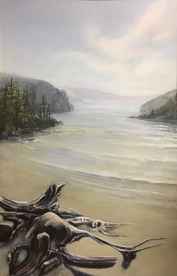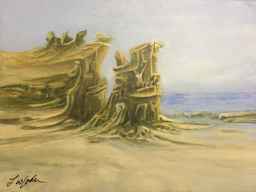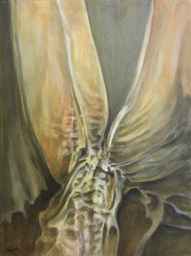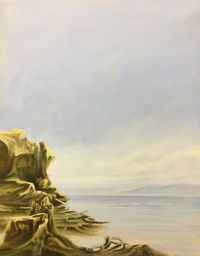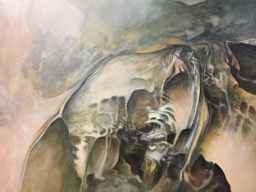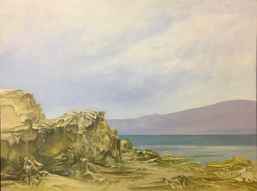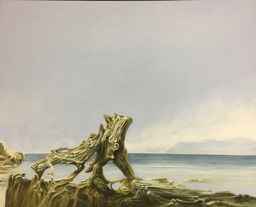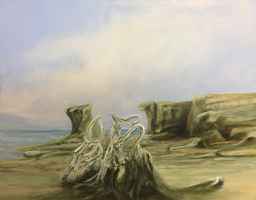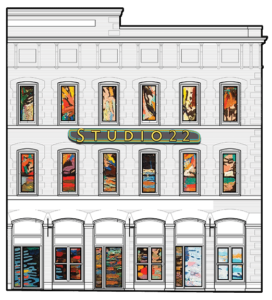LW Foden
Born in Belleville, Ontario and raised in Kapuskasing, Foden grew up surrounded by vast forest and waterways. He considers those views to be his first inspiration. Foden left home in the early 60s to attend the Ontario College of Art in Toronto. In 1965 he left the college and moved to Vancouver where he focused mainly on printmaking and etchings. During his time on the coast he attended the Vancouver College of Art where he continued to hone his skills as a visual artist. What followed were a few years of travelling around Canada, the United States and Mexico before Foden found himself back in Toronto. He experimented with various art forms — both the practical and the purely aesthetic. He took jobs in costume and set design, airbrushing, voiceover work and even modelling. In the early 80s, Foden decided not to take on anymore of the “just for bills” jobs. He rented a space in an old Toy Factory and turned the open room into a paint studio and devoted everything to painting. In 1994 Foden moved to Galiano Island, British Columbia where he has continued to create and sell his paintings.

IN MEMORY of an artist and a dear friend - LW FODEN

On December 14th, 2020, our artist Larry Foden (LW) passed away. He was 78 years old. He had a 50 year friendship with Hersh and was godfather to our eldest son. He was an important person in our lives. We are sad that he has left us but grateful that his artwork remains to always recall the man and provide a glimpse into aspects of the world he sought to highlight and elevate. His beloved Galiano Island shines more brightly because it touched him and inspired the impulses of his brush.
Our gallery had a very long relationship with Foden. Though he did not have a solo exhibit with Studio22 until the spring of 2019, a small selection of his work – first small prints and then a very large painting – was exhibited by our gallery from its early days. Foden lived and worked on Galiano Island, British Columbia. It took the gallery a long time and then a considerable effort to both convince the artist and facilitate the transfer of artwork from BC to Studio22 in Ontario for a feature exhibit of his Galiano paintings. Bones of the Earth turned out to be the last major exhibition of his life. The work, itself, was a culmination of more than 25 years of watching, touching and breathing the Salish Sea and her landforms. As noted in a write up for the exhibit, Looking at his work it’s hard not to imagine the artist himself as a stone marked by years at sea. Now that he is no longer here with us, it is these stones, these paintings that will forever bring forth his life for us.
– Ally & Hersh Jacob
Available Artwork
Archive
Not currently available – If you are interested in this, please contact us.
Not currently available – If you are interested in this, please contact us.
Not currently available – If you are interested in this, please contact us.
Previous
Next
- Sold
- Not currently available
- Not available online
- On Lease
- Not Available
MORE
Back to the Bones
by Aviva Jacob
You could call it a lifetime of landscapes.
Throughout his career, Larry Foden (76), has managed to capture the human element of some of Canada’s unique views — but you won’t find a single person in his work.
Born in Belleville, Ontario and raised in Kapuskasing, Foden grew up surrounded by vast forest and waterways. He considers those views to be his first inspiration.
“Very early on as a kid I did landscape painting because that’s all there was [to look at]. Right?”
Foden left home in the early 60s to attend the Ontario College of Art in Toronto. In 1965 he left the college and moved to Vancouver where he focused mainly on printmaking and etchings. During his time on the coast he attended the Vancouver College of Art where he continued to hone his skills as a visual artist.
What followed were a few years of travelling around Canada, the United States and Mexico before Foden found himself back in Toronto. He experimented with various art forms — both the practical and the purely aesthetic. He took jobs in costume and set design, airbrushing, voiceover work and even modelling. “But that was all to pay the bills,” he says.
I don’t think I ever felt in any way that I was missing out or not able to do something — not able to to do my work — because I was always doing it in one way or another.”
At that point he was simply “along for the ride.”
“I got a call one day from somebody that I barely knew who told me that I should send out an application to the University of Windsor because they were looking for a costume designer. I had no idea there was even a university in Windsor. I sent an application in and got the job.”
Foden spent three years as the lead costume designer in the University of Windsor’s Theatre Department before moving back to Toronto.He continued his work in the theatre, taking over as the Props Master at Toronto’s Centre Stage Theatre. He held that position for two years.
In the early 80s, Foden decided not to take on anymore of the “just for bills” jobs. He rented a space in an old Toy Factory and turned the open room into a paint studio.
“It was beautiful — 15 foot windows, lots of light. It wasn’t cheap but boy was it beautiful,” says Foden. “That’s when I devoted everything to my painting,”
That year — at 43 — he returned to his childhood home in Kapuskasing, Ontario. There, he reunited with the landscapes that inspired him in his early days.
“It was very strange in a way. It certainly brought back a lot of very positive and very negative energies. It’s the Canadian shield. So it’s a lot of granite and a lot of waterfalls. I had one favourite area where I could sit out any on these flat rocks and paint the waterfalls. I realized at that point — and I’m sure it influenced me forever — I realized that the stone never changes and the water is always constant. But it takes the water and its constancy to make a mark on the stone.”
“It was the sandstone that just immediately attracted me. You know sometimes it’s like being an an archaeologist and you’re digging and scraping away and all of a sudden you discovered something, and in this case you discover a pattern; you discover a colour. Sometimes these images look like they’re prehistoric, not really like stone… they’re just solidified versions of something very old.”
In 1994 Foden visited a friend on Galiano Island, British Columbia. What started as a six week vacation became a permanent home. He heard about a small cottage on the seaside overlooking the Georgia Strait and jumped on the opportunity. Still on the island today, his address has only changed once. He lived in that very cottage for over 20 years and now lives centrally in the small town on Galiano.
“I’m nestled in the woods where as before I was nestled by the water. I don’t have the water now and I miss it but I have other things around me. And I think it’s good. I’ve got a number of years ahead of me to explore this new space; this new place.”
Foden’s current body of work is Galiano. Bones of the Earth is a collection of paintings from his years on the Island. This is where you’ll see his ability to anthropomorphize landscape.
“I see figures [in the earth]. I don’t necessarily exaggerate them or in any way set them apart but they are there.”
The relationship between the rocks and the sea is captured from the vantage of his cottage on the shore. In the 20 years he spent with that view he watched the constant of the rocks and the change of the sea and imagined the lifetime they lived together before he came along.
Today, exploring his new views, his own constant has changed. Looking at his work it’s hard not to imagine the artist himself as a stone marked by years at sea.
Larry Foden, Wheels of Fortune
By Keith Holmes
“I was born in Kapuskasing Ontario – a Precambrian wilderness of silent rock eroded by active waters… an environment rich in the archetypal mysteries of creation. The magic and timeless beauty of nature… the wheel of life and eternity.
In the pattern of a wheel, turning full circle, my education carried me from the ecology and culture of Northern Ontario to the culture of mountains and coastal myths. The second turn of the wheel brought me to the pre-columbian arts and culture of Mexico. Yet another turn brought new discoveries with my journey back to the rocks of my childhood; that place of solitude and memory.
I studied the content, techniques and styles of art history while exploring and developing my skills in a variety of mediums. The art, culture and unique natural beauty of the landscape familiar to me began to shape my directions in art.
My apprenticeship completed; my timeless place found in the closing of a circle: those threads of my experience, having woven themselves into the foundations my future work.
My first 50 years were ones of exploration and discovery. My next 50 will be doing that which I most love to do… create images.”
Larry Foden wrote this short autobiography soon after he moved to Galiano in 1994… and Galiano has been the great beneficiary of his of years of exploration and discovery. His feeling for the elemental natural beauty of his childhood years in Northern Ontario, revisited again in maturity has finally emerged here as an extensive body of highly refined art work. Larry’s lifelong fascination with the interplay of rock and water resonate so well with the intricate tafoni rock formations sculpted under the relentless action of water on the sandstone shorelines of these Gulf Islands. Here he has produced, in his waterfront studio, a visual study and extrapolation on the subject without compare.
The circuitous route by which Larry landed on Galiano shows through, not only in his masterful knowledge as painter and print maker, but also his uncommon insight into a vast array of subjects. This will be especially clear to the very many people who got to know him across the counter in Galiano Island Books; often they left the store with a renewed interest in something they’d hardly thought of.
Larry says in his life he always pursued his own natural interests rather than career considerations. Thus he slid easily from a youthful exploration of classical ballet and choreography into the visual arts when he found himself avoiding the dance studio in order to do drawing. Two and a half years at the Ontario College of Art, Toronto and a couple more at the Vancouver College of Art gave him all the formal training he needed to launch himself into the multifaceted world of the fine arts with its deep cultural roots. Larry plunged in. His first show in a commercial gallery, the Doug Christmas Gallery in the West End of Vancouver, got a review in the Vancouver Sun that dubbed his work “neo-surrealist”. Fair enough. The west coast of Canada, itself a labyrinth of interplay between rock and water, its huge natural growth and powerful aboriginal art motifs can have a strong impact on the visually sensitive person. Their mystique held Larry in Vancouver for several years. With his many skills he was able to support himself in a variety of ways, from designing, making and dying cloths to selling his visual art and other crafts.
Eventually, like many young Canadians, Larry responded to the call of the tropics. Never one to do things by half measures, he sold everything in Vancouver and moved to a small fishing village on the Gulf of Mexico. Here he painted under the brilliant tropical sun. His longtime interest in fabrics and fibre also drew his attention to the refined skill of the local indigenous people who spun natural fibers and wove them into unique items such as the famous Mexican web hammock. He connected with the local crafts people and began to acquire some of their extensive ancient knowledge.
Larry explored this life for about a year before Canada called him back, this time back again to Toronto. There he found his many diverse skills in demand. His new fibre-arts constructions stimulated by recently acquired knowledge brought him an invitation to take a high-profile spot exhibiting and demonstrating at The World Craft Fair hosted by the Ontario Science Centre. This was a singular experience; a matchless opportunity to show, learn and make invaluable diverse acquaintances.
Perhaps inevitably Larry’s burgeoning skills opened opportunities for him in theatre. He worked a few of these until, to his surprise, he was recommended for a position as resident costume designer at the University of Windsor. “The job”, he says “was horrendous but it was great… non-stop, 24/7 ..But…” with the high-pressure work his skills and confidence took another leap forward. When a very good position opened up as Props Master at Toronto’s Centre Stage Theatre, he applied for the job and got it.
About this time an ideal studio space became available and a very good friend of Larry’s said to him: “Foden, if you don’t do this (take the studio) you’re going to be a bitter old man.” Larry must have listened because he did take the space and that, he considers, was the moment when he seriously began the work he continues today: “creating images”. With the studio he eased himself out of the day-to-day work force to address his deeper interests; a new beginning for Larry or, as he suggests, another turn of the wheel. Accordingly he began to travel back to his roots for inspiration; back up into the Precambrian north where all life orbits the interplay of water and rock. In good Canadian tradition Larry, sometmes with with friends, would travel north for research, then take his material back to Toronto for further development in his studio. This became Larry’s way of life until he decided to return again to the west coast, not to the city this time but to here where the ocean washes the rock. The rest, as they say, is local history.











